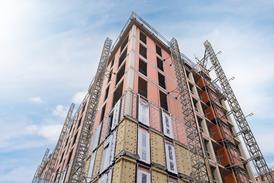In this week’s issue, keeping up with new technology in doors and windows, the whole-life costs of factory-finished doorsets and all the latest portal-related products. But first, the many ways in which you can reduce solar gain
Playing it cool
The need to prevent overheating in buildings without resorting to energy-intensive air-conditioning is becoming an increasingly urgent problem. According to the BRE Trust, rising temperatures are leading to a corresponding 6.5% increase in the percentage of mechanically cooled floor space in the UK each year. This is at an energy cost of 55 kW/hr per m2 per year.
In response to statistics such as these, BRE has come out with a timely publication called Summertime Solar Performance of Windows with Shading Devices. The guide says that the rise can be halted by a combination of solar shading and night ventilation – measures that are cheaper than installing mechanical cooling and far more environmentally friendly. Indeed, it says the cost of installing appropriate solar shading could be recouped in just five years.
Of course, how successful solar shading is in reducing overheating depends on several factors. These include the orientation of the window, and whether the shading device is fitted outside the window, mid-pane or inside the building. Other factors include the shape of the shading device and its optical properties.
The BRE guide provides data to quantify the effectiveness of solar shading devices, describes the terms used to quantify solar control and explains the different approaches that can be used. It also gives data on the effectiveness of different types of solar shading devices and provides a methodology to compare different types of device. Below we provide a brief guide to some of the types of solar shading outlined in the book. If more generalised guidance is required on this topic, see the BRE publication Solar Shading of Buildings.
www.bre.co.uk
External overhang

How it works Attached to the building above the glazed area to provide shade
Advantages and disadvantages
- Good at blocking high-angle summer sun on south-facing facades
- Does not block the view out of the window
- Not adjustable
Solar transmittance 0.46 (solar transmittance through a plain, unshaded double glazed unit is 1. All figures denote effectiveness in summer)
Light shelf

How it works An overhang is fitted against the window at the same level as the occupants’ heads inside the building. Extra light reflects off the top of this into the building.
Advantages and disadvantages
- Effective on south-facing facades
- Although it is visible from inside the building it has very little effect on the view out of the window
- Not adjustable
Solar transmittance 0.51
External blind or louvre

How it works A range of blinds is available including external Venetian blinds, roller blinds and controllable louvres. These work by directly blocking the sunlight and stopping it passing through the window
Advantages and disadvantages
- Very good at blocking sunlight and controlling glare
- Can be adjusted to suit the amount of light – for example, some types can be completely retracted in winter
- Partially blocks the view out of the window when closed
Solar transmittance Open 0.31, closed 0.17
Mid-pane blind

How it works A blind is fitted into the cavity in a double-glazing unit
Advantages and disadvantages
- More effective than an internal blind
- Controls glare
- It doesn’t get dirty as quickly
- Can be adjusted, and the window can be opened without the blind getting in the way
Solar transmittance Closed 0.34 (mid-pane Venetian blind)
Internal blind
How it works Venetian or roller blind is fitted inside the building to block sun
Advantages and disadvantages
- Particularly easy and cheap to retrofit
- Good at controlling glare and adjustable
- Not as effective as mid-pane or external blinds as the blind heats up and transfers heat into the room. This can be mitigated by using materials that have a reflective surface facing the window
Solar transmittance Venetian blind 0.66, roller blind 0.59, reflective roller blind 0.34
Solar control glass

How it works Two types are available – absorbing glasses with a tint and reflective glasses with a coating
Advantages and disadvantages
- Apart from the tint it doesn’t block the view
- Advanced heat mirror coatings are particularly good at balancing blocking heat without affecting the amount of light passing through the glass as it blocks infrared light. This type of coating also cuts down on heat loss in winter
- Absorbing glasses are not as effective as reflective glasses as they heat up and transfer heat into the building
- Needs to be specified before construction
Solar transmittance Tinted glazing 0.3-0.7, heat mirror 0.3-0.6 (varies according to glass type)
Solar control film

How it works A solar control film is stuck onto existing glazing.
Advantages and disadvantages
- Easily retrofitted
- Has similar advantages as dedicated solar control glass although not as durable.
Solar transmittance 0.4-0.6 (varies according to glass type)
Doors and Windows
- 1
- 2
- 3
- 4
- 5
 Currently reading
Currently readingDoors and windows

























No comments yet